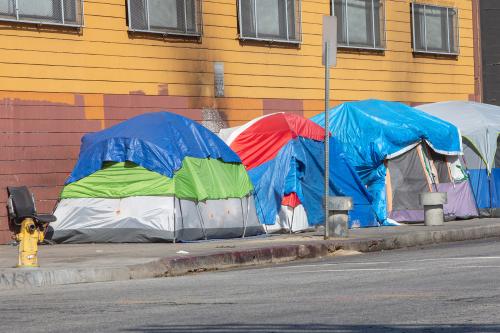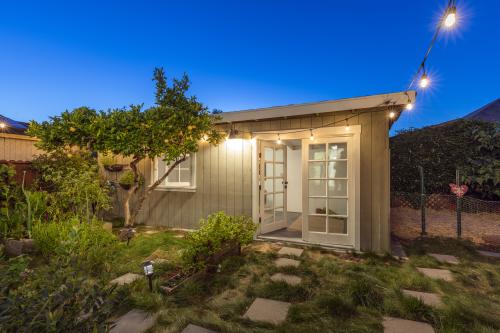From the era of frontier cabins to suburbs lined with white picket fences, a single-family house with a yard has lived in the popular imagination as a symbol of American virtue and prosperity. Conversely, urban neighborhoods with dense housing—particularly, Black and brown communities—have been depicted as crowded and dangerous. Evidence of this old yet durable narrative can be found almost a century ago in the Supreme Court’s 1926 ruling that established the principle of exclusionary land use zones in the United States: “[V]ery often the apartment house is a mere parasite, constructed in order to take advantage of the open spaces and attractive surroundings created by the residential character of the district.”
This distorted picture of the American Dream amplifies the socioeconomic challenges many low-income and middle-class families face. Single-family zoning is a pivotal contributor to the housing affordability crisis because it both limits the supply of housing and enables inefficient use of existing housing inventory and land in already scarce desirable, sustainable places. In fact, the share of large single-family homes in the overall U.S. housing inventory has grown over the past four decades, even as the average household size has declined. Residential zoning is also a critical social justice issue; the racist and classist roots of single-family zoning are well documented, and a growing body of evidence suggests that the practice has led to higher levels of residential segregation.
Housing is by far American households’ single largest expense. Therefore, the foundation of an efficient, integrated, and sustainable society is a flexible and affordable housing system. To create that system, we need to end single-family zoning and legalize more diverse housing options in urban, suburban, and rural areas alike. To that end, several U.S. cities and states have started reforming their zoning regulations. In this brief, we examine the relationship between U.S. neighborhoods’ share of detached single-family homes and their demographic and economic characteristics to understand the potential impact of such zoning reforms. We present evidence that “if you build it, they will come,” and neighborhoods with more diverse housing inventory are in fact more racially diverse.
Exclusionary zoning amplifies racial segregation and restricts opportunity
Contemporary residential segregation by race does not occur purely by choice and preference. Rather, today’s ongoing segregation is the product of policy design. One such policy is single-family zoning.
Exclusive single-family zoning was adopted to create and maintain racially segregated neighborhoods and concentrate poverty within particular neighborhoods. Evidence suggests that such residential segregation and concentrated poverty undermine the promise of transformative placemaking, creating economic and social barriers to physical and civic health in many low-income and BIPOC communities.
- Single-family zoning is an opportunity hoarding mechanism. Persistent residential segregation exacerbates racial disparities in income and wealth. Two recent studies on single-family zoning in the San Francisco Bay Area and Los Angeles showed how single-family zoning excludes low-income families and people of color from opportunities to get high-quality education, earn a livable wage, and build wealth. In high-demand places, single-family zoning can also further limit access to educational and employment opportunities by restricting the housing supply, thereby increasing housing prices and decreasing affordability.
- Single-family zoning is harmful to community well-being. Residential segregation results in a disproportionate distribution of environmental health burdens along racial lines. Across all kinds and colors of neighborhoods, single-family zoning maximizes land consumption for housing, creating car-dependent neighborhoods with greater travel distances, more car trips, more traffic, and more emissions. Consequently, these neighborhoods’ social realm shifts from public spaces like sidewalks to private spaces like yards, with a corresponding decrease in social capital.
- Single-family zoning is expensive. Minimum lot sizes, required setbacks, and detached single-family zoning’s other restrictions require residents to purchase or rent more land than they might personally need in order to obtain shelter, while preventing many owners from maximizing their land’s utility. At the community level, pushing growth to the fringe in order to avoid intensifying existing residential development means spreading finite fiscal resources ever further away from already underinvested core neighborhoods.
- Single-family zoning can heighten social exclusion and tensions. Living in segregated neighborhoods can influence one’s social identity and attitudes toward oneself and others. One study found that people in segregated conditions had greater intergroup bias, indicating discriminatory attitudes toward those outside their group. Moreover, a growing body of research suggests that concentrated poverty can also weaken social cohesion, trust, and willingness to help others.
- Single-family zoning manifests imbalances of power between neighborhoods. Concentrated poverty and segregation negatively influence civic participation and civic knowledge. In fact, wealthy neighborhoods tend to be more organized and successful in preventing new development.
Building more diverse housing can help build inclusive neighborhoods
To document the prevalence of detached single-family housing in the U.S. and explore the relationship between neighborhood housing inventory and racial and economic segregation, we undertook a new analysis of the 2014-2019 American Community Survey. Three core findings stood out: detached single-family homes dominate most neighborhoods; less housing diversity means less racial diversity, but not necessarily less income diversity; and white neighborhoods—the highest share of which are in the suburbs—have larger shares of single-family homes.
Detached single-family homes dominate most neighborhoods—even urban ones
Detached single-family houses are often thought of as a suburban phenomenon. Indeed, suburban areas have the largest share (19%) of exclusively detached single-family housing neighborhoods. Still, while city neighborhoods tend to have more diverse housing inventory than suburban and rural areas, detached single-family houses can still be easily found in many urban communities.(i) Figure 1 shows that detached single-family homes compose the majority of the housing inventory in 47% of urban neighborhoods in the U.S. This is in part because “[i]t is illegal on 75 percent of the residential land in many American cities to build anything other than a detached single-family home,” as The Upshot reported. In short, U.S. communities have significant room for more and more diverse housing, including in our urban cores.
 Neighborhoods with less diverse housing inventory tend to be less racially diverse—but only partly because of affordability
Neighborhoods with less diverse housing inventory tend to be less racially diverse—but only partly because of affordability
Table 1 shows that neighborhoods with lower shares of single-family housing units—indicating more diverse housing inventory—tend to have substantially higher racial entropy scores(ii) (a statistic where the hypothetical maximum is 1). More specifically, neighborhoods where a majority of housing options are not detached single-family units (for example, townhouses or apartments) reported a population-weighted median entropy score of 0.62—higher than the national median. This means that racial groups are more evenly represented in neighborhoods with more diverse housing inventory. However, the entropy scores for household income quintiles in Table 1 show only a modest relationship between a neighborhood’s housing inventory mix and income diversity. Neighborhoods with more diverse inventory are somewhat more mixed income than those where single-family housing makes up nearly the entire stock. But despite the common perception, most neighborhoods are comprised of residents with a mix of incomes regardless of their degree of housing diversity.
These divergent findings for racial and economic integration can be explained in part by the incumbent status of existing homeowners. The vast majority (85%) of detached single-family homes are owner-occupied, and owners tend to move infrequently: Nationwide, 67% of homeowners have lived in their current home for over 10 years, and 37% have been in their home for more than 20 years.(iii) It is therefore not surprising that in neighborhoods where the housing inventory is overwhelmingly dominated by detached single-family homes that were first occupied in the not-so-distant days of de jure racial segregation, the pace of neighborhoods’ racial integration is slower than the national trend. By the same token, even today’s high-priced single-family neighborhoods may still be mixed income due to the fact that owners who purchased their homes years ago may have done so when prices were more affordable for less affluent residents than they are today.
 White neighborhoods—the highest share of which are in the suburbs—have larger shares of single-family homes
White neighborhoods—the highest share of which are in the suburbs—have larger shares of single-family homes
A strong relationship exists between race and neighborhood housing type—and thus between race and geography. Figure 2 illustrates the unique way in which white neighborhoods are skewed toward higher shares of single-family housing. It shows that neighborhoods where the largest racial group is Black, Latino or Hispanic, or Asian American are often neighborhoods with the most diverse housing inventory (lower shares of single-family housing units), while white-plurality neighborhoods with diverse housing units are rare outliers. This pattern is consistent with research finding that restrictive zoning was adopted to separate white families from everyone else.
 Public policy contributed to these patterns in other ways as well, creating divergence not only by housing type, but by geography. Enormous government programs such as the 1862 Homestead Act and post-World War II federally subsidized home loans incentivized the white population’s migration from cities to suburbs and rural areas. The forced relocation of Native Americans to reservations explains the similar distribution of housing inventory in both white and Native neighborhoods.
Public policy contributed to these patterns in other ways as well, creating divergence not only by housing type, but by geography. Enormous government programs such as the 1862 Homestead Act and post-World War II federally subsidized home loans incentivized the white population’s migration from cities to suburbs and rural areas. The forced relocation of Native Americans to reservations explains the similar distribution of housing inventory in both white and Native neighborhoods.
Figure 3 shows the geographic distribution of neighborhoods based on the largest racial group by share living in those neighborhoods. Suburbs have the largest share of tracts (40%) in which the dominant group is white. Urban, small metro, and rural areas have far smaller shares of predominantly white neighborhoods. By contrast, urban areas have the largest share of tracts in which the dominant group is either Black (54%), Latino or Hispanic (47%), and AAPI (55%).
The upshot of these patterns is that there is simply a large number of white people in the U.S. who live in suburban communities that are relatively homogeneous in both the race of their neighbors and the kind of structure (single-family homes) they live in. Black, Latino or Hispanic, and AAPI groups may also live in racially homogenous neighborhoods, but those neighborhoods are more likely to be urban or suburban and vary in terms of their dominant housing type.

Ending exclusionary zoning can uplift people, neighborhoods, and the entire nation
This analysis finds that segregation by race is prevalent in our communities due to housing patterns that are being created and maintained by exclusionary zoning and land use practices. These patterns come at high economic cost for individuals and a high social cost for society as a whole. They have also helped to create a political dynamic in which the politics of understanding, prioritizing, and accommodating the needs of people and places in more diverse urban settings is heavily racialized. This dynamic will only become more detrimental as the nation diversifies, and as the ability of jurisdictions within metropolitan regions to cooperate around shared economic and climate challenges becomes ever more vital.
Neutralizing the power of some neighborhoods to exclude would expand opportunity for traditionally isolated groups such as Black people and immigrants, reduce social tension, and balance power between neighborhoods. Many higher-income residents of predominantly single-family neighborhoods fear that zoning changes that increase housing inventory diversity will negatively impact their property values, because new residents will be lower-income. However, our findings show that neighborhoods with diverse housing inventory are not substantially lower-income than exclusively single-family neighborhoods. This is consistent with other research that has found that legalizing apartments, including subsidized low-income housing, does not negatively affect property values, and even sometimes increases land values by capitalizing new development potential.
Mounting problems of housing affordability, inequality, and climate change have shown that the American Dream has become increasingly unreachable, inequitable, and unsustainable for many families and the planet. Efforts by states and localities to end single-family zoning and legalize more diverse housing options can reverse this course—while also creating more vibrant, healthy, socially just, and prosperous neighborhoods. Transformation of zoning, in other words, can lead to a transformation of places.
The authors thank Randolph Hohle and Rushaine Goulbourne for reviewing earlier drafts of this piece and providing helpful comments and feedback.
[i] We define “urban” as census tracts located in principal cities of the 110 largest metro areas with populations over 500,000; “suburban” as tracts located outside of principal cities of the 110 largest metro areas; “small metro” as tracts in other midsized and small metro areas; and “rural” as tracts in micropolitan areas and the rest of the country.
[ii] Defining “diverse housing” and an “integrated” neighborhood is inevitably arbitrary. As the Othering and Belonging Institute notes, there are many measures of segregation and diversity. For this research brief, we used entropy scores, as a measure that ranges from 0 to 1 and is designed to evaluate the diversity of an area unit of analysis. We used five mutually exclusive racial and ethnic groups for race entropy scores: non-Hispanic white; Black or African American; Asian American, Native Hawaiian, and Other Pacific Islander (AAPI); American Indian and Alaska Native; and Latino or Hispanic. For income diversity, we counted housing units occupied by households with incomes less than $25,000; incomes between $25,000 and $50,000; between $50,000 and $75,000; between $75,000 and $100,000; and $100,000 or more. We then calculated entropy scores that measure how evenly the households with different incomes are distributed within the area. A “perfect” entropy score of 1, when calculated for five groups, indicates that the area is composed of one-fifth (20%) of each of the five groups. We extracted estimates on detached single-family home units for housing inventory, and race and ethnic composition and financial characteristics of households from the Census Bureau’s American Community Survey 2015-2019 5-Year Estimates via Social Explorer. It is important to note that this data reflects the actual housing inventory that exists in a neighborhood, and not the category of zoning.
[iii] 2015-2019 American Community Survey 5-Year estimates






Commentary
Diverse neighborhoods are made of diverse housing
February 8, 2022